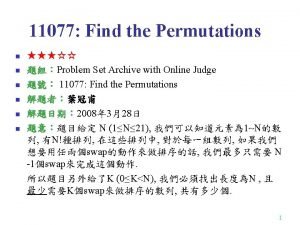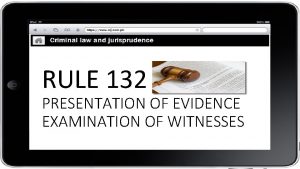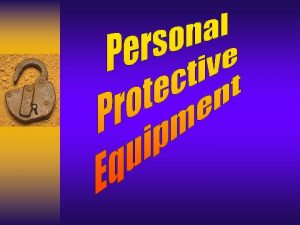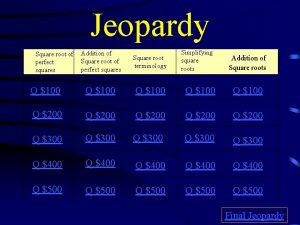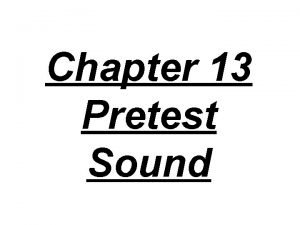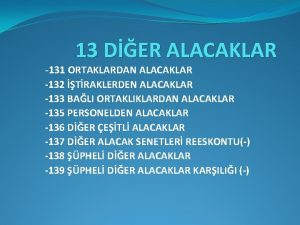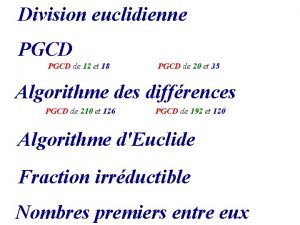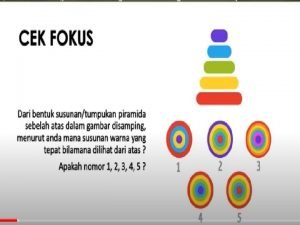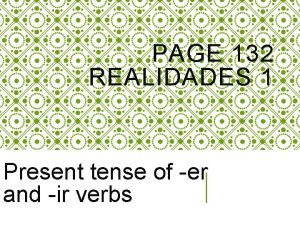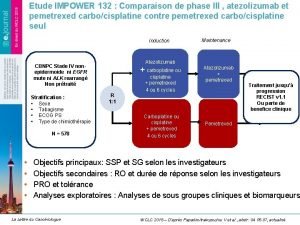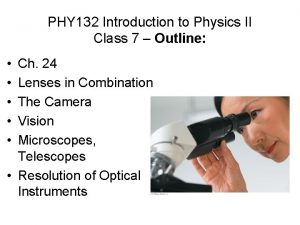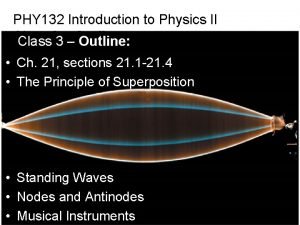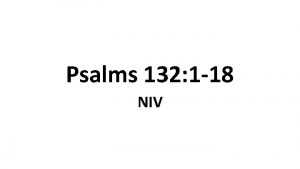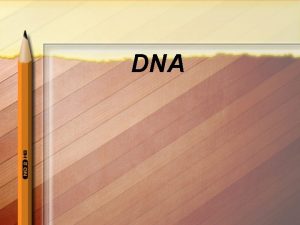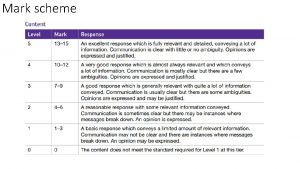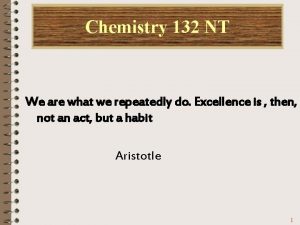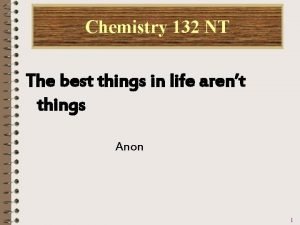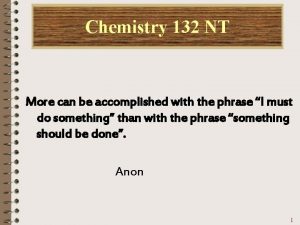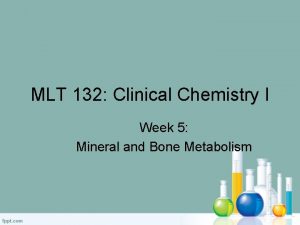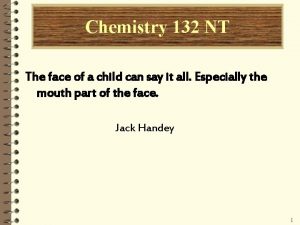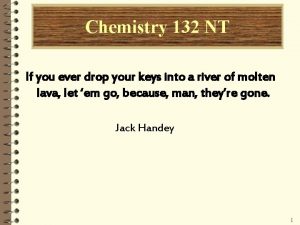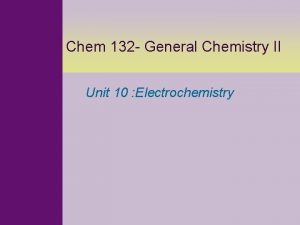Chemistry 132 NT It is the mark of


















































- Slides: 50

Chemistry 132 NT It is the mark of an instructed mind to rest satisfied with the degree of precision that the nature of a subject permits, and not to seek exactness where only an approximation of the truth is possible. Aristotle 1

2

Acid-Base Equilibria Chapter 16 Module 2 Sections 16. 3 and 16. 4 Reaction of zinc metal with hydrochloric acid. 3

Review Determining Ka (or Kb) from the solution p. H Calculating the concentration of a species in a weak acid solution using Ka Calculating concentrations of species in a solution of a diprotic acid. 4

Base-Ionization Equilibria involving weak bases are treated similarly to those for weak acids. Ammonia, for example, ionizes in water as follows. The corresponding equilibrium constant is: 5

Base-Ionization Equilibria involving weak bases are treated similarly to those for weak acids. Ammonia, for example, ionizes in water as follows. The concentration of water is nearly constant. 6

Base-Ionization Equilibria involving weak bases are treated similarly to those for weak acids. In general, a weak base B with the base ionization has a base ionization constant equal to Table 16. 2 lists ionization constants for some weak bases. 7

A Problem To Consider What is the p. H of a 0. 20 M solution of pyridine, C 5 H 5 N, in aqueous solution? The Kb for pyridine is 1. 4 x 10 -9. As before, we will follow the three steps in solving an equilibrium. 1. Write the equation and make a table of concentrations. 2. Set up the equilibrium constant expression. 3. Solve for x = [OH-]. 8

A Problem To Consider What is the p. H of a 0. 20 M solution of pyridine, C 5 H 5 N, in aqueous solution? The Kb for pyridine is 1. 4 x 10 -9. Pyridine ionizes by picking up a proton from water (as ammonia does). Starting 0. 20 Change -x Equilibrium 0. 20 -x 0 +x x 9

A Problem To Consider What is the p. H of a 0. 20 M solution of pyridine, C 5 H 5 N, in aqueous solution? The Kb for pyridine is 1. 4 x 10 -9. Note that which is much greater than 100, so we may use the simplifying assumption that (0. 20 -x) (0. 20). 10

A Problem To Consider What is the p. H of a 0. 20 M solution of pyridine, C 5 H 5 N, in aqueous solution? The Kb for pyridine is 1. 4 x 10 -9. The equilibrium expression is 11

A Problem To Consider What is the p. H of a 0. 20 M solution of pyridine, C 5 H 5 N, in aqueous solution? The Kb for pyridine is 1. 4 x 10 -9. If we substitute the equilibrium concentrations and the Kb into the equilibrium constant expression, we get 12

A Problem To Consider What is the p. H of a 0. 20 M solution of pyridine, C 5 H 5 N, in aqueous solution? The Kb for pyridine is 1. 4 x 10 -9. Using our simplifying assumption that the x in the denominator is negligible, we get 13

A Problem To Consider What is the p. H of a 0. 20 M solution of pyridine, C 5 H 5 N, in aqueous solution? The Kb for pyridine is 1. 4 x 10 -9. Solving for x we get 14

A Problem To Consider What is the p. H of a 0. 20 M solution of pyridine, C 5 H 5 N, in aqueous solution? The Kb for pyridine is 1. 4 x 10 -9. Solving for p. OH Since p. H + p. OH = 14. 00 (see Exercises 16. 5 and 16. 6 and Problems 16. 41 and 16. 43) 15

Acid-Base Properties of a Salt Solution One of the successes of the Brønsted-Lowry concept of acids and bases was in pointing out that some ions can act as acids or bases. Consider a solution of sodium cyanide, Na. CN. A 0. 1 M solution has a p. H of 11. 1 and is therefore fairly basic. 16

Acid-Base Properties of a Salt Solution One of the successes of the Brønsted-Lowry concept of acids and bases was in pointing out that some ions can act as acids or bases. Sodium ion, Na+, is un-reactive with water, but the cyanide ion, CN-, reacts to produce HCN and OH-. 17

Acid-Base Properties of a Salt Solution One of the successes of the Brønsted-Lowry concept of acids and bases was in pointing out that some ions can act as acids or bases. From the Brønsted-Lowry point of view, the CN- ion acts as a base, because it accepts a proton from H 2 O. H+ 18

Acid-Base Properties of a Salt Solution One of the successes of the Brønsted-Lowry concept of acids and bases was in pointing out that some ions can act as acids or bases. You can also see that OH- ion is a product, so you would expect the solution to have a basic p. H. This explains why Na. CN solutions are basic. The reaction of the CN- ion with water is referred to as the hydrolysis of CN-. 19

Acid-Base Properties of a Salt Solution The hydrolysis of an ion is the reaction of an ion with water to produce the conjugate acid and hydroxide ion or the conjugate base and hydronium ion. The CN- ion hydrolyzes to give the conjugate acid, HCN, and hydroxide. 20

Acid-Base Properties of a Salt Solution The hydrolysis of an ion is the reaction of an ion with water to produce the conjugate acid and hydroxide ion or the conjugate base and hydronium ion. The hydrolysis reaction for CN- has the form of a base ionization so you write the Kb expression for it. 21

Acid-Base Properties of a Salt Solution The hydrolysis of an ion is the reaction of an ion with water to produce the conjugate acid and hydroxide ion or the conjugate base and hydronium ion. The NH 4+ ion hydrolyzes to the conjugate base (NH 3) and hydronium ion. 22

Acid-Base Properties of a Salt Solution The hydrolysis of an ion is the reaction of an ion with water to produce the conjugate acid and hydroxide ion or the conjugate base and hydronium ion. This equation has the form of an acid ionization so you write the Ka expression for it. 23

Predicting Whether a Salt is Acidic, Basic, or Neutral How can you predict whether a particular salt will be acidic, basic, or neutral? The Brønsted-Lowry concept illustrates the inverse relationship in the strengths of conjugate acid-base pairs. Consequently, the anions of weak acids (poor proton donors) are good proton acceptors. Anions of weak acids therefore, are basic. 24

Predicting Whether a Salt is Acidic, Basic, or Neutral How can you predict whether a particular salt will be acidic, basic, or neutral? One the other hand, the anions of strong acids (good proton donors) have virtually no basic character, that is, they do not hydrolyze. For example, the Cl- ion, which is conjugate to the strong acid HCl, shows no appreciable reaction with water. 25

Predicting Whether a Salt is Acidic, Basic, or Neutral How can you predict whether a particular salt will be acidic, basic, or neutral? Conversely, the cations of weak bases are acidic. One the other hand, the cations of strong bases have virtually no acidic character, that is, they do not hydrolyze. For example, 26

Predicting Whether a Salt is Acidic, Basic, or Neutral To predict the acidity or basicity of a salt, you must examine the acidity or basicity of the ions composing the salt. Consider potassium acetate, KC 2 H 3 O 2. The potassium ion is the cation of a strong base (KOH) and does not hydrolyze. 27

Predicting Whether a Salt is Acidic, Basic, or Neutral To predict the acidity or basicity of a salt, you must examine the acidity or basicity of the ions composing the salt. Consider potassium acetate, KC 2 H 3 O 2. The acetate ion, however, is the anion of a weak acid (HC 2 H 3 O 2) and is basic. A solution of potassium acetate is predicted to be basic. 28

Predicting Whether a Salt is Acidic, Basic, or Neutral These rules apply to normal salts (those in which the anion has no acidic hydrogen) 1. A salt of a strong base and a strong acid. The salt has no hydrolyzable ions and so gives a neutral aqueous solution. An example is Na. Cl. 29

Predicting Whether a Salt is Acidic, Basic, or Neutral These rules apply to normal salts (those in which the anion has no acidic hydrogen) 2. A salt of a strong base and a weak acid. The anion of the salt is the conjugate of the weak acid. It hydrolyzes to give a basic solution. An example is Na. CN. 30

Predicting Whether a Salt is Acidic, Basic, or Neutral These rules apply to normal salts (those in which the anion has no acidic hydrogen) 3. A salt of a weak base and a strong acid. The cation of the salt is the conjugate of the weak base. It hydrolyzes to give an acidic solution. An example is NH 4 Cl. 31

Predicting Whether a Salt is Acidic, Basic, or Neutral These rules apply to normal salts (those in which the anion has no acidic hydrogen) 4. A salt of a weak base and a weak acid. Both ions hydrolyze. You must compare the Ka of the cation with the Kb of the anion. If the Ka of the cation is larger the solution is acidic. If the Kb of the anion is larger, the solution is basic. (see Exercise 16. 7 and Problem 16. 49) 32

The p. H of a Salt Solution To calculate the p. H of a salt solution would require the Ka of the acidic cation or the Kb of the basic anion. (see Figure 16. 8) The ionization constants of ions are not listed directly in tables because the values are easily related to their conjugate species. Thus the Kb for CN- is related to the Ka for HCN. 33

The p. H of a Salt Solution To see the relationship between Ka and Kb for conjugate acid-base pairs, consider the acid ionization of HCN and the base ionization of CN. Ka Kb Kw When these two reactions are added you get the ionization of water. 34

The p. H of a Salt Solution To see the relationship between Ka and Kb for conjugate acid-base pairs, consider the acid ionization of HCN and the base ionization of CN. Ka Kb Kw When two reactions are added, their equilibrium constants are multiplied. 35

The p. H of a Salt Solution To see the relationship between Ka and Kb for conjugate acid-base pairs, consider the acid ionization of HCN and the base ionization of CN. Ka Kb Kw Therefore, For HCN For CN- 36

A Problem To Consider Use Tables 16. 1 and 16. 2 to obtain the following at 25 o. C. : (a) Kb for CN- and (b) Ka for NH 4+. (a)The conjugate acid of CN- is HCN, whose Ka is 4. 9 x 10 -10 (Table 16. 1). Therefore, 37

A Problem To Consider Use Tables 16. 1 and 16. 2 to obtain the following at 25 o. C. : (a) Kb for CN- and (b) Ka for NH 4+. (a)The conjugate acid of CN- is HCN, whose Ka is 4. 9 x 10 -10 (Table 16. 1). Therefore, Note that the Kb for CN- is approximately equal to Kb for ammonia, NH 3 (1. 8 x 10 -5). 38

A Problem To Consider Use Tables 16. 1 and 16. 2 to obtain the following at 25 o. C. : (a) Kb for CN- and (b) Ka for NH 4+. (a)The conjugate acid of CN- is HCN, whose Ka is 4. 9 x 10 -10 (Table 16. 1). Therefore, This means the base strength of CN- is comparable with that of NH 3. 39

A Problem To Consider Use Tables 16. 1 and 16. 2 to obtain the following at 25 o. C. : (a) Kb for CN- and (b) Ka for NH 4+. (b)The conjugate base of NH 4+ is NH 3, whose Kb is 1. 8 x 10 -5 (Table 16. 2). Therefore, 40

A Problem To Consider Use Tables 16. 1 and 16. 2 to obtain the following at 25 o. C. : (a) Kb for CN- and (b) Ka for NH 4+. (b)The conjugate base of NH 4+ is NH 3, whose Kb is 1. 8 x 10 -5 (Table 16. 2). Therefore, NH 4+ is a relatively weak acid. Acetic acid, by comparison has a Ka equal to 1. 8 x 10 -5. (see Exercise 16. 8 and Problem 16. 53) 41

The p. H of a Salt Solution For a solution of a salt in which only one ion hydrolyzes, the calculation of equilibrium composition follows that of weak acids and bases. The only difference is first obtaining the Ka or Kb for the ion that hydrolyzes. The next example illustrates the reasoning and calculations involved. 42

A Problem To Consider What is the p. H of a 0. 10 M Na. CN solution at 25 o. C? The Ka for HCN is 4. 9 x 10 -10. Sodium cyanide gives Na+ ions and CN- ions in solution. Only the CN- ion hydrolyzes. 43

A Problem To Consider What is the p. H of a 0. 10 M Na. CN solution at 25 o. C? The Ka for HCN is 4. 9 x 10 -10. The CN- ion is acting as a base, so first, we must calculate the Kb for CN-. Now we can proceed with the equilibrium calculation. 44

A Problem To Consider What is the p. H of a 0. 10 M Na. CN solution at 25 o. C? The Ka for HCN is 4. 9 x 10 -10. Let x = [OH-] = [HCN], then substitute into the equilibrium expression. 45

A Problem To Consider What is the p. H of a 0. 10 M Na. CN solution at 25 o. C? The Ka for HCN is 4. 9 x 10 -10. This gives We can use our simplifying assumption to ignore this “x” 46

A Problem To Consider What is the p. H of a 0. 10 M Na. CN solution at 25 o. C? The Ka for HCN is 4. 9 x 10 -10. Solving the equation, you find that Hence, As expected, the solution has a p. H greater than 7. 0. (see Exercise 16. 9 and Problems 16. 55 and 16. 57) 47

Operational Skills Calculating the concentration of a species in a weak base solution using Kb Predicting whether a salt solution is acidic, basic, or neutral Obtaining Ka from Kb or Kb from Ka Calculating concentrations of species in a salt solution 48

Homework Chapter 16 Homework: collected at the first exam. Review Questions: 7. Problems: 43, 51, 55, 87, 101. Time for a few review questions 49

50
 123 132 213 231 312 321
123 132 213 231 312 321 Rule 132
Rule 132 29cfr1910.132
29cfr1910.132 Rapid city gangs
Rapid city gangs Impower 132
Impower 132 10 ejemplos de decenas de millar
10 ejemplos de decenas de millar Impower 132
Impower 132 Square root jeopardy
Square root jeopardy What phenomenon is created by two tuning forks
What phenomenon is created by two tuning forks 131 hesap nedir
131 hesap nedir Algorithme division par soustractions successives
Algorithme division par soustractions successives 24 sonetas
24 sonetas Krakowska korv
Krakowska korv Hasil dari 108 + 132 dikurang 134 =
Hasil dari 108 + 132 dikurang 134 = Grundpotensform
Grundpotensform Advanced dc motors inc
Advanced dc motors inc Sfas no 132
Sfas no 132 Present tense of er and ir verbs page 132
Present tense of er and ir verbs page 132 Impower 132
Impower 132 Clases de bienes
Clases de bienes What is farsightedness called
What is farsightedness called Phy 132
Phy 132 Cse 132
Cse 132 132,000 ves
132,000 ves Articulo 132 lomce
Articulo 132 lomce Cse 132c
Cse 132c Cse 132
Cse 132 Comunidad prefa
Comunidad prefa Ib chemistry functional groups
Ib chemistry functional groups Inorganic chemistry vs organic chemistry
Inorganic chemistry vs organic chemistry 2019 ib grade boundaries
2019 ib grade boundaries Hình ảnh bộ gõ cơ thể búng tay
Hình ảnh bộ gõ cơ thể búng tay Bổ thể
Bổ thể Tỉ lệ cơ thể trẻ em
Tỉ lệ cơ thể trẻ em Chó sói
Chó sói Glasgow thang điểm
Glasgow thang điểm Chúa yêu trần thế alleluia
Chúa yêu trần thế alleluia Môn thể thao bắt đầu bằng chữ f
Môn thể thao bắt đầu bằng chữ f Thế nào là hệ số cao nhất
Thế nào là hệ số cao nhất Các châu lục và đại dương trên thế giới
Các châu lục và đại dương trên thế giới Công thức tính độ biến thiên đông lượng
Công thức tính độ biến thiên đông lượng Trời xanh đây là của chúng ta thể thơ
Trời xanh đây là của chúng ta thể thơ Mật thư anh em như thể tay chân
Mật thư anh em như thể tay chân 101012 bằng
101012 bằng Phản ứng thế ankan
Phản ứng thế ankan Các châu lục và đại dương trên thế giới
Các châu lục và đại dương trên thế giới Thơ thất ngôn tứ tuyệt đường luật
Thơ thất ngôn tứ tuyệt đường luật Quá trình desamine hóa có thể tạo ra
Quá trình desamine hóa có thể tạo ra Một số thể thơ truyền thống
Một số thể thơ truyền thống Bàn tay mà dây bẩn
Bàn tay mà dây bẩn
